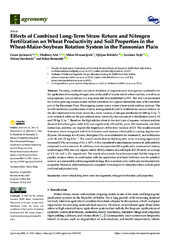Приказ основних података о документу
Effects of Combined Long-Term Straw Return and Nitrogen Fertilization on Wheat Productivity and Soil Properties in the Wheat-Maize-Soybean Rotation System in the Pannonian Plain
| dc.creator | Jaćimović, Goran | |
| dc.creator | Aćin, Vladimir | |
| dc.creator | Mirosavljević, Milan | |
| dc.creator | Brbaklić, Ljiljana | |
| dc.creator | Vujić, Svetlana | |
| dc.creator | Dunđerski, Dušan | |
| dc.creator | Šeremešić, Srđan | |
| dc.date.accessioned | 2023-06-08T08:30:40Z | |
| dc.date.available | 2023-06-08T08:30:40Z | |
| dc.date.issued | 2023 | |
| dc.identifier.issn | 2073-4395 | |
| dc.identifier.uri | http://fiver.ifvcns.rs/handle/123456789/3578 | |
| dc.description.abstract | The study, conducted to evaluate the effects of long-term straw management combined with the application of increasing nitrogen rates on the yield of twenty winter wheat varieties, as well as on soil properties, was carried out in a long-term field trial established in 1971. The trial was monitored for twenty growing seasons under rainfed conditions in a typical chernozem zone of the southern part of the Pannonian Plain. The cropping system was a winter wheat-maize-soybean rotation. The ten SN-treatments (combinations of straw management (S) and N-fertilization) were as follows: In the plot (treatment) with straw return (S1), seven variants of nitrogen fertilization (0–180 kg N ha−1) were included, while on the plot without straw return (S0) the variants of N-fertilization were 0, 90 and 150 kg N ha−l. Based on the high relative share in the total sum of squares, variance analysis showed that wheat grain yield (GY) was significantly affected by years, SN-treatments, and their interaction, and they can explain the largest part of the total variance of GY. The results showed that straw return integrated with N fertilization could increase wheat yield to varying degrees over 20 years. On average, for all years, the highest GYs were obtained in the treatment S1 and fertilization with 180 and 150 kg N ha−1. The overall results showed that long-term straw returning significantly increased GY by an average of 8.4 ± 4.5%, with a considerable simultaneous increase in yield stability compared to straw removal. In addition, straw incorporation (SI) significantly increased soil humus, total nitrogen (TN), and soil organic carbon (SOC) contents at a soil depth of 0–30 cm by an average of 4.2, 3.8, and 11.3%, respectively. The results of our study have demonstrated that the long-term practice of straw return, in combination with the application of mineral fertilizers, has the potential to serve as a sustainable soil management strategy that is economically viable and environmentally acceptable. However, additional research is required to investigate its interactive effects on both grain yield and soil productivity. | sr |
| dc.language.iso | en | sr |
| dc.publisher | Basel : MDPI | sr |
| dc.relation | info:eu-repo/grantAgreement/MESTD/inst-2020/200117/RS// | sr |
| dc.relation | info:eu-repo/grantAgreement/MESTD/inst-2020/200032/RS// | sr |
| dc.relation | APV 142-451-3152/2022-01/2: Winter wheat nitrogen use efficiency improvement in Vojvodina / Unapređenje efikasnosti upotrebe azota kod ozime pšenice u Vojvodini, financed by the Provincial Secretariat for Higher Education and Scientific Research, AP Vojvodina | sr |
| dc.rights | openAccess | sr |
| dc.rights.uri | https://creativecommons.org/licenses/by/4.0/ | |
| dc.source | Agronomy - Basel | sr |
| dc.subject | winter wheat | sr |
| dc.subject | straw management | sr |
| dc.subject | long-term straw management | sr |
| dc.subject | nitrogen fertilization | sr |
| dc.subject | soil properties | sr |
| dc.subject | wheat | sr |
| dc.subject | maize | sr |
| dc.subject | soybean | sr |
| dc.subject | Pannonian plain | sr |
| dc.title | Effects of Combined Long-Term Straw Return and Nitrogen Fertilization on Wheat Productivity and Soil Properties in the Wheat-Maize-Soybean Rotation System in the Pannonian Plain | sr |
| dc.type | article | sr |
| dc.rights.license | BY | sr |
| dc.citation.issue | 6 | |
| dc.citation.rank | M21~ | |
| dc.citation.spage | 1529 | |
| dc.citation.volume | 13 | |
| dc.identifier.doi | 10.3390/agronomy13061529 | |
| dc.identifier.fulltext | http://fiver.ifvcns.rs/bitstream/id/9521/agronomy-13-01529-v2.pdf | |
| dc.identifier.scopus | 2-s2.0-85164030118 | |
| dc.type.version | publishedVersion | sr |


